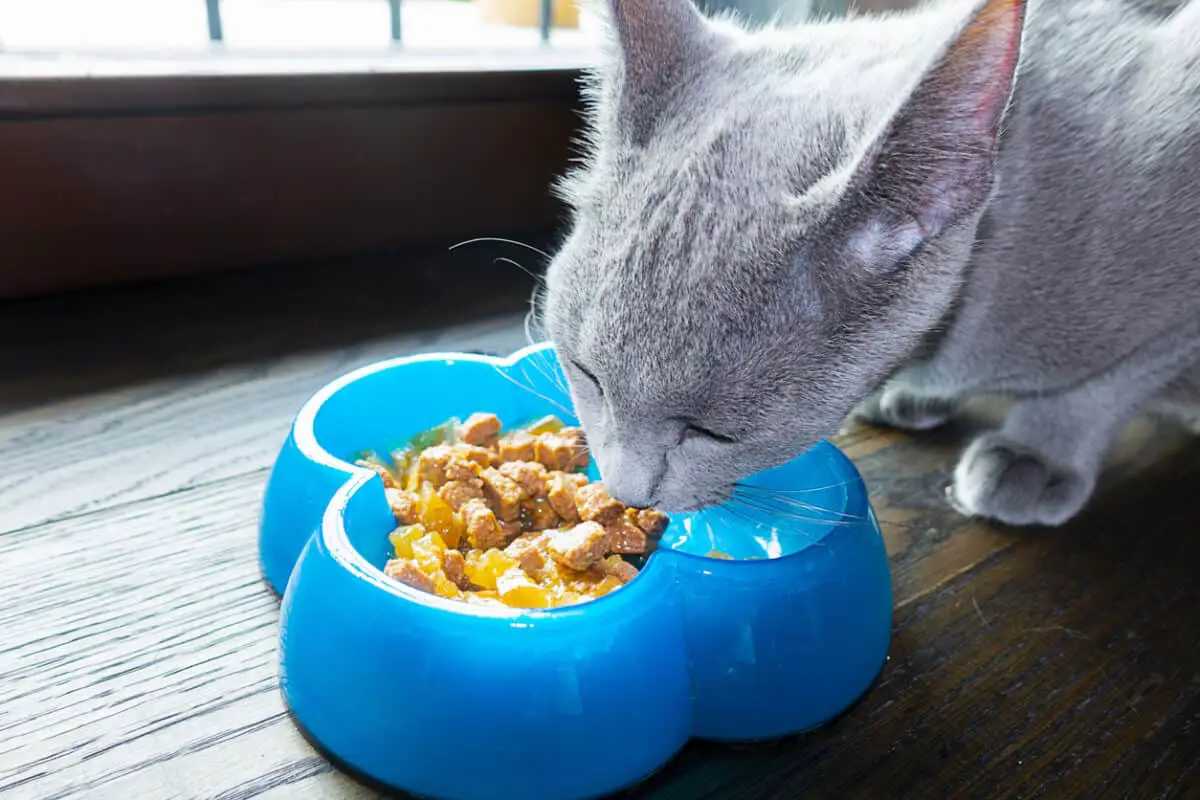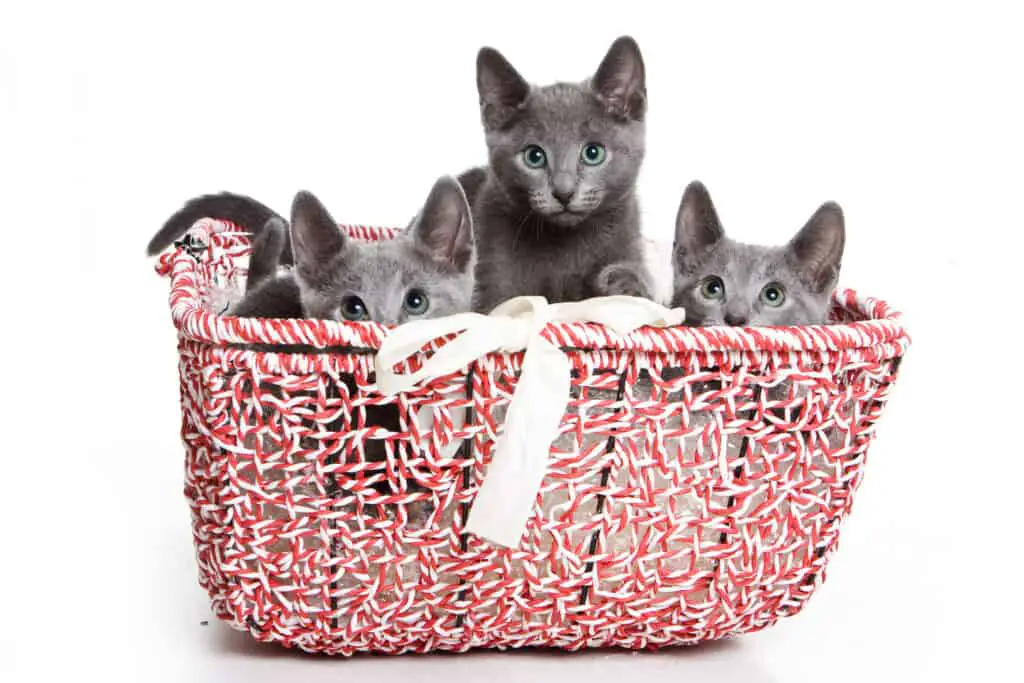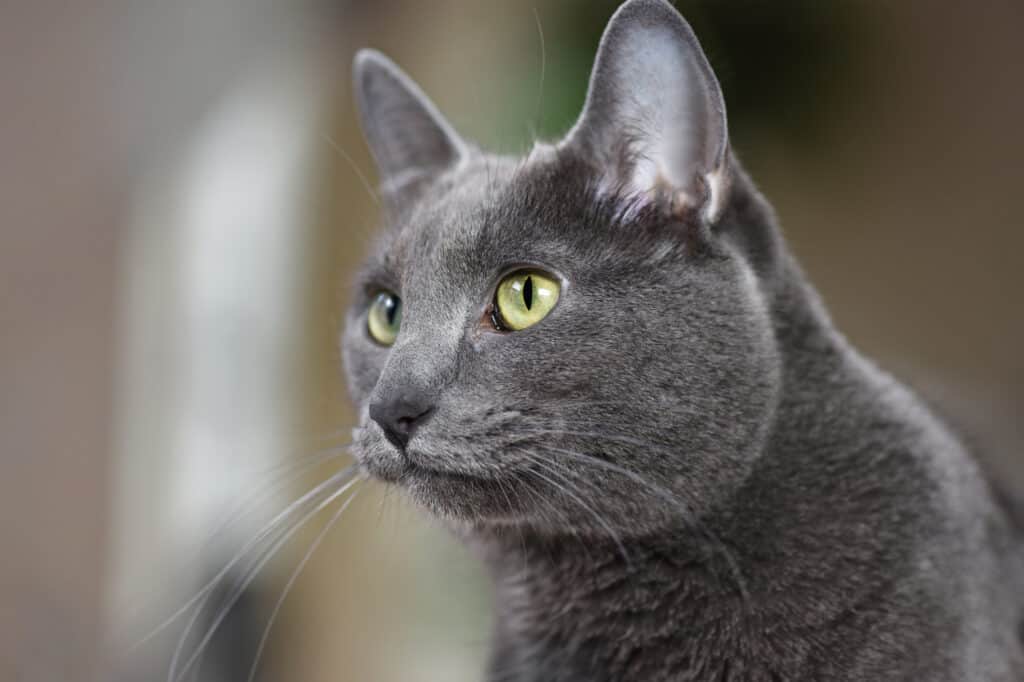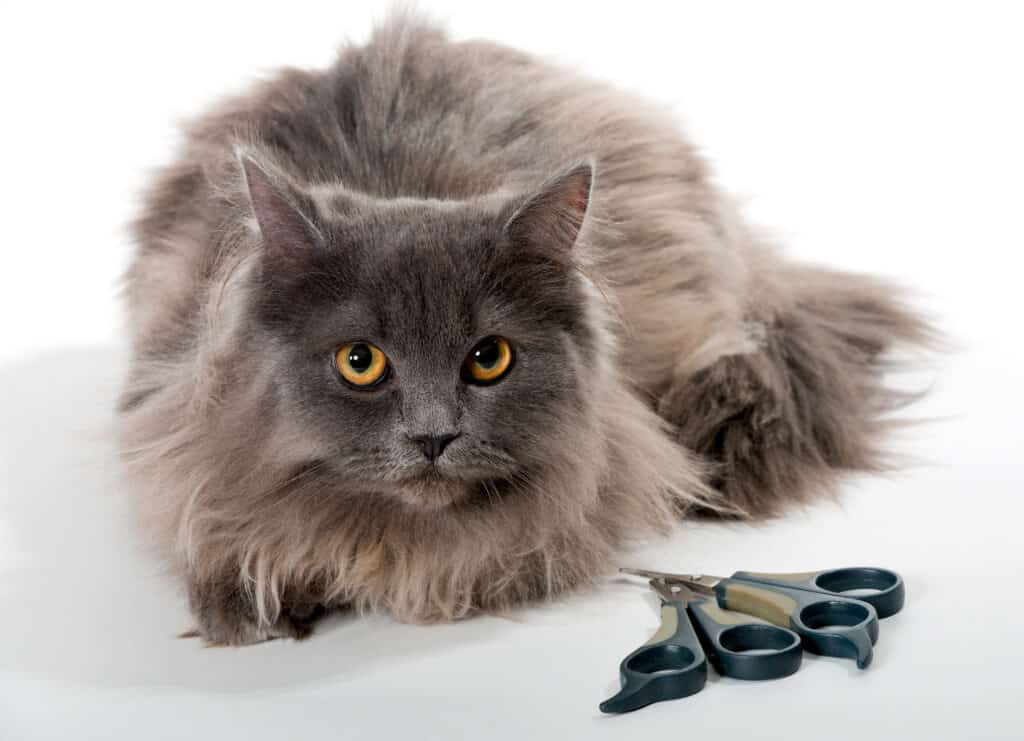Russian Blue cats are very popular because of their beautiful green eyes, laid-back personality, and because they go well with families and kids.
After many years of owning a gorgeous Russian Blue cat myself, I can confirm that they LOVE to eat. Managing a Russian Blue’s weight is essential to keep them healthy.
As many Russian Blues enjoy ‘the good life’ in their forever homes, it’s not uncommon to see some developing overweight.
Do Russian Blue cats get fat?
Russian blue cats are at risk of developing overweight. This is because their love for food makes them exceptionally prone to obesity. They are also not particularly active and persistent in seducing their owners to feed them.
Anyone with a Russian Blue cat in their home knows it’s hard to resist the cries and begging for food, snacks, and treats. Many of us give in to this because we love our cats and want to spoil them.
However, spoiling your cat with lots of treats is bad for them. Like humans, overweight Russian blues will pay the price with many health-related problems caused by obesity.
Because this cat breed is not particularly active and doesn’t exercise a lot, they don’t burn sufficient calories to avoid the risk of obesity.
What’s the “healthy” weight for a Russian blue cat?
To ensure that your Blue isn’t getting too pudgy, it is helpful to know your cat’s average weight and height at different ages.
Knowing your cat’s target weight will be the first step to determining if they are overweight or not.
Be careful with kittens
At birth, a healthy Russian Blue kitten will weigh about 3 to 4 ounces, then reach 1 pound b the time it is five weeks old.
At ten weeks, its weight would’ve doubled to 2 pounds—and since it’s now ready to wean from mother’s milk and eat cat food, there’s a big chance that it can overeat.
Be careful, though! Kittens are very active and growing a lot as well. It is, therefore, only natural to be more hungry since they burn many calories. Underfeeding a kitten is very detrimental to their health and is something to avoid at all times.
At 16 weeks or four months, an average Russian Blue kitten should be around 5 pounds. From there, it will gain about 1 or 2 pounds every month: 6 pounds at five months, 8 pounds at six months, etc.
What ideal weight to aim for?
An adult cat of 12 months and older should weigh about 8 to 15 pounds.
The upper limit of 15 pounds is more on the chubby side. If you want to play it safe, aim for the middle of this range, say 11 pounds.
When your Russian Blue cat is creeping closer to 15 pounds, it’s a good idea to start monitoring and limiting its food intake.
Ideal weight table – Russian Blue Cats
| Age | Ideal weight |
|---|---|
| Newborn | 3 to 4 ounces – 85-113 grams |
| 2 weeks | 6 to 8 ounces – 170-226 grams |
| 5 weeks | 1 pound – 453 grams |
| 10 weeks | 2 pounds – 900 grams |
| 16 weeks | 5 pounds – 2.3 Kg |
| 20 weeks (5 months) | 6 pounds – 2.7 Kg |
| 24 weeks (6 months) | 8 pounds – 3.6 Kg |
| Adult: 12 months and older | 8 to 15 pounds – 3.6 – 6.8 Kg |
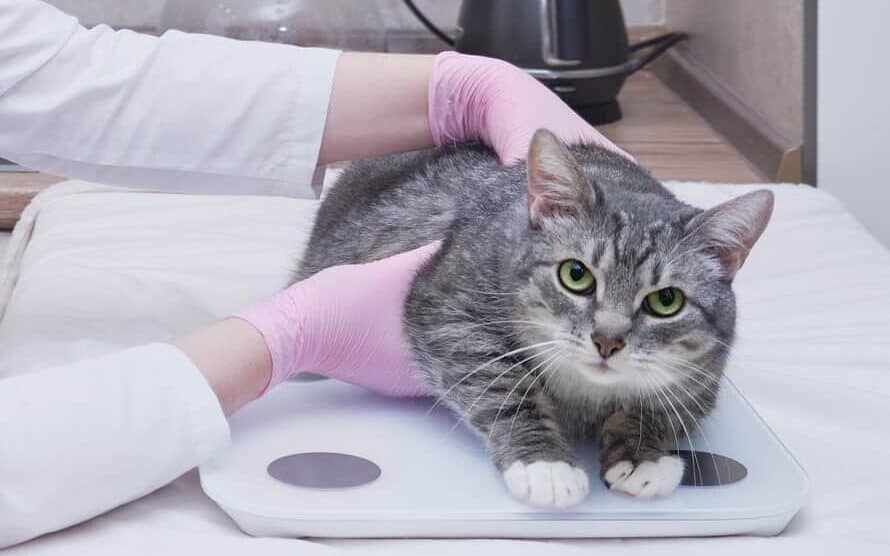
What are physical signs that Your Russian Blue is getting fat?
At their ideal weight, Russian Blues are muscular and slender cats with well-defined body shapes. Hence a Blue with a belly or a thick back is most likely overweight.
On the other hand, they do have thick fur because of their double coat. This may sometimes make them appear more chunky than they really are.
Many Russian Blue cat owners may think that their cat is just ‘fluffy’, not fat. Here’s how to quickly test this.
Aside from the weighing scale, you can do a quick physical exam.
An easy test for overweight
- Look at your cat lying down on its belly or in the loaf position. Check if you see a thinner area at the waist and hipbone protruding from the cat’s body. If not, that could signify that your Russian Blue is getting fat.
- Watch your cat while it walks. Is their clear belly fat or low-hanging fat?
- Run your hands along the spine, feeling through the fur. Can you feel the bones in the spine? If not, that’s a sign that it’s developing a thick layer of fat.
- Place your cat on your lap and then gently feel the rib cage. While some fat there is healthy, you should still be able to feel the bones.
Of course, the best person to confirm whether your fur baby is getting fat is the vet. If you’re concerned, bring it for a checkup.
How to easily weigh your Russian Blue?
Everyone who owns a cat knows that having a cat stay still in a certain place is challenging. They could do this for hours except when you want them to stand still on a scale for 10 seconds.
You will also know that cats love card boxes. You can use this to your advantage.
Persuade your cat to sit in the cardboard box, which shouldn’t be hard to do. Then place the box, including your cat, on the scales to easily measure their weight.
Don’t forget to subtract the empty box’s weight from the measured weight. Some scales allow you to weigh the box first and then reset it to zero before putting the cat in.
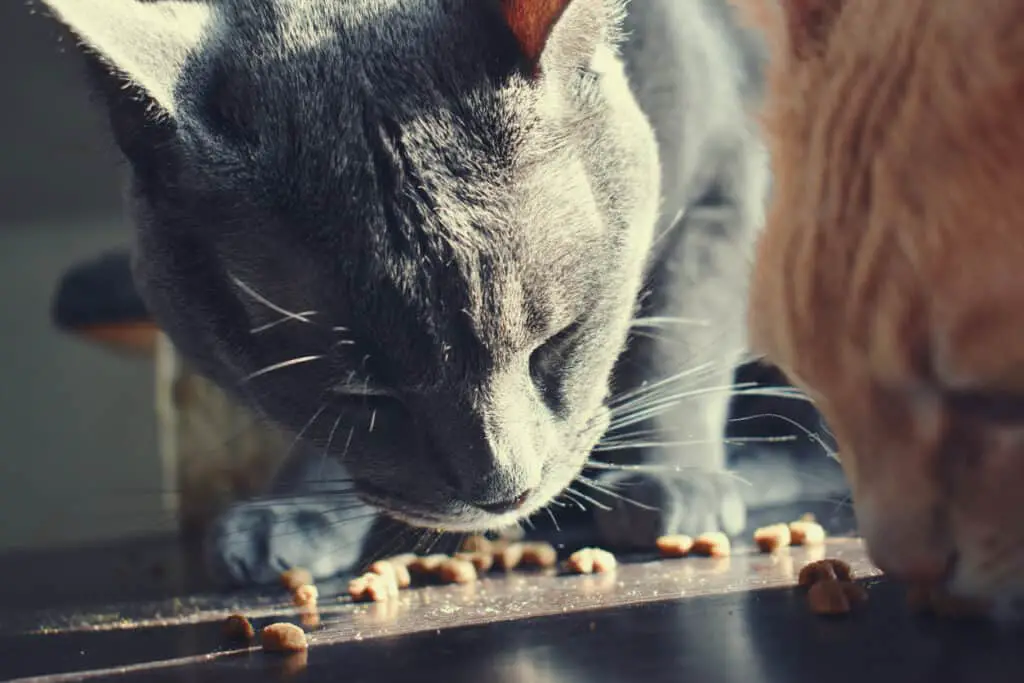
How Much Food Does A Russian Blue Need Per Day?
To answer this question, there are a lot of factors to take into account. For example, the age, weight, activity level, and whether yours is an indoor versus an outdoor cat, just to name a few.
This question is, therefore, best answered by your veterinarian, who can take all these things into account.
However,…
We can give a ballpark number to aim for. According to Fetch by WebMD, cats need between 24 and 35 calories per day per pound of body weight.
This means that if your Russian Blue cat weighs 10 pounds, it would need between (24 * 10) = 240 and (35 * 10) = 350 calories per day.
If we’d aim for the middle, then about 280-300 calories per day would be ideal.
How to accurately calculate calorie intake?
When you’re not used to this, calculating the calorie intake and getting the correct distribution over the day is tricky.
On the other hand, anyone who’s ever followed a diet will be comfortable doing this.
Most canned and packed cat food states the number of calories it contains for the entire pack and per 100 grams/ounce of product. The latter is what we need to calculate how much food we should feed your kitty.
Let’s say the vet determined that your Blue needs 300 calories daily. It’s a good idea to spread this out over, let’s say, three equal amounts per day.
On top of the regular feedings, you may also give your cats some treats throughout the day. This is perhaps 20 calories, leaving 280 calories for regular meals.
If you feed your cat wet food and kibble, the calculations look like this.
Wet cat food typically contains 70-100 calories per 100 grams, whereas kibble would be about 350 calories per 100 grams
Based on these assumptions, an example of a feeding schedule would look like this.
| Time of Day | Meal | Calories | Weight |
|---|---|---|---|
| Morning | Breakfast – Wet food | ~95 calories | 70-100 grams. Depending on the food. |
| Afternoon | Lunch – Kibble | ~95 calories | about 25 grams |
| Evening | Dinner – Wet food | ~95 calories | 70-100 grams. Depending on the food. |
| Throughout Day | Snack/treat | 15 calories | It depends on the snack, about what fits in the palm of your hand. |
| Total | 300 calories |
Why is my Russian blue cat getting fat?
We love our cats, so It’s only natural to want to pamper them a bit. The best way to show love isn’t to give treats but to ensure they’re healthy and can live a long and happy life.
If you notice signs of obesity as described above, check for possible causes of the problem and correct your habits accordingly.
Overfeeding
Pet owners’ biggest mistake is filling the cat bowl to the brim. The cat will eat everything in one sitting or return to its bowl several times a day.
As discussed above, cats should eat smaller amounts throughout the day. This also mimics their natural eating pattern as hunters.
Cats in the wild also catch and eat several smaller prey throughout the day.
Vets recommend giving regular meals rather than free-feeding or leaving food in the bowl for them to nibble on throughout the day.
Russian blues, in particular, have a temperament that needs routine and familiarity, and they often lack the self-control not to overeat if food is ever-present. Scheduling meals can give them a predictable environment.
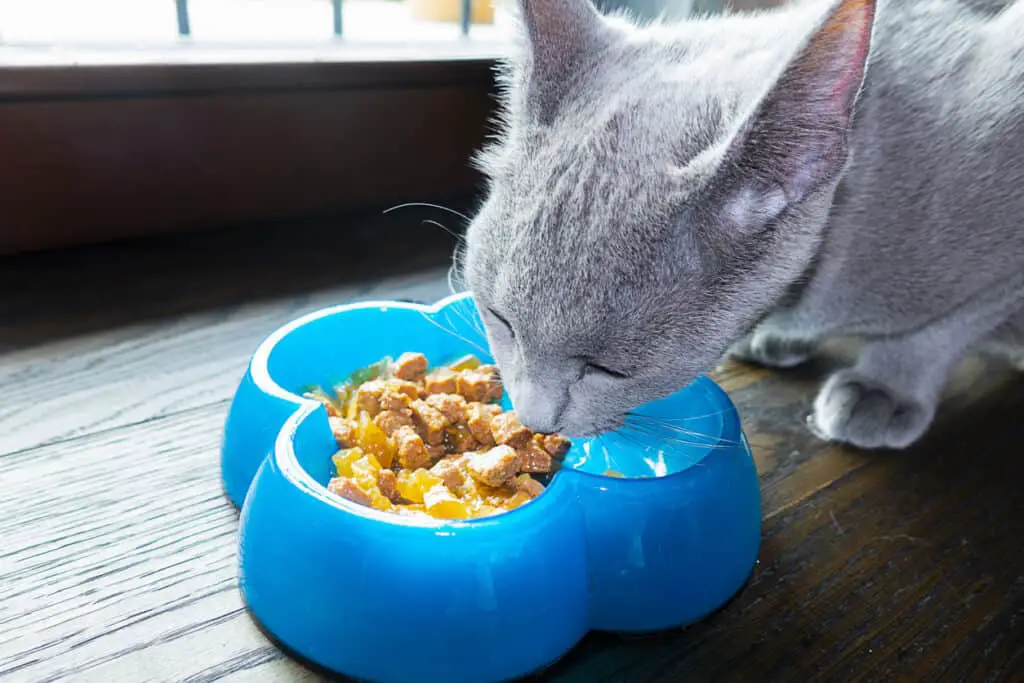
Boredom
Another reason cats may overeat, which goes hand in hand with the habit of free-feeding, is that cats start to eat out of boredom. This is primarily a risk for indoor cats.
When there is too little distraction for a cat throughout the day, they might get bored. They will start eating if an entire bowl of food is available. Not because they’re hungry but because they don’t have anything better to do.
Avoid this behavior by not free-feeding and giving your cat something to do, encouraging mental stimulation by supplying toys, or simply giving the cat access to a window to look at what’s happening outside.
Too many treats
It’s okay to give a few treats, especially if you’re training your Russian blue cat or want to provide it with something special while you cuddle on the couch.
However, limit snacks to 10% of the total daily calories. As mentioned above, setting up a feeding schedule is a great idea. You can include the daily snacks in that schedule.
Not enough exercise and activity
Russian blues are moderately active cats and typically get the exercise they need from playing with toys and the occasional “zoomies”. However, an overweight cat will need to get more exercise.
In general, this is more of an issue with indoor cats. Cats who have to option to go outside usually get enough exercise.
It’s a great idea to get your cat some toys that encourage your pet to run or reach and scratching posts where they can stretch. Please avoid laser pointers, as this will only frustrate your cat!
As a rule of thumb, try to spend 20-30 minutes a day playing with your Russian Blue. This will give them a chance to get exercise while they play. It will also strengthen the bond between the both of you.
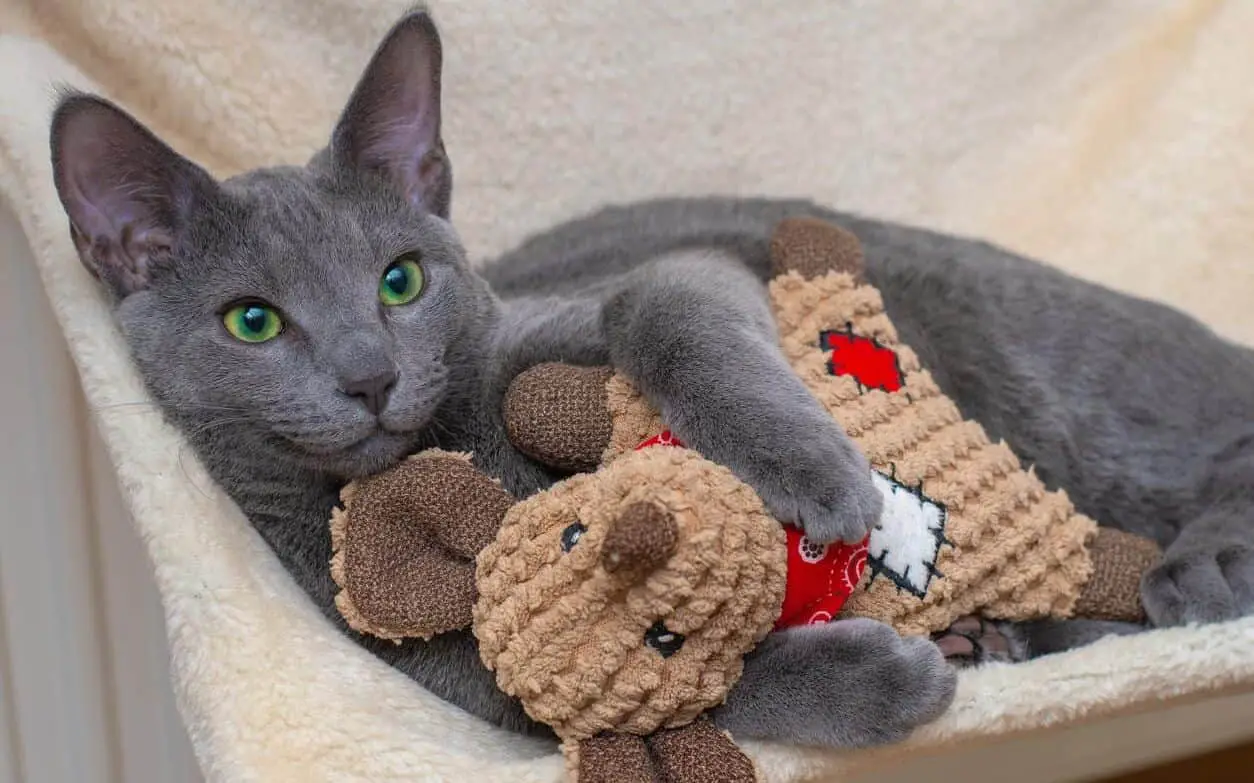
Age
Older cats will have a slower metabolism and use less energy throughout the day because they’re less active.
Besides the metabolism, which slows down as cats get older, their nutritional requirements may also change over time.
It’s a good idea to review your feeding habits or feeding schedule when your cat gets older. Your vet can advise on what your Russian Blue cat needs as it ages.
Possible disease or health problems
Russian blues generally have fewer health problems and a lower chance of disease than other purebreds because they are a natural cat breed.
However, they can still develop some conditions—and inactivity or sudden weight changes can be a symptom.
For example, hypothyroidism disease can affect your cat’s metabolism, and heart or respiratory problems can make them more sluggish and less likely to play.
Low-Quality food
Your cat may be fat but still have nutritional deficiencies. Some pet food has a lot of fillers.
Many of the cheaper cat foods are equivalent to what we would call “junk food”. Eating this once in a while is okay, but it shouldn’t be your main diet. The same goes for cats.
This low-quality food may hurt your Russian Blue cat because it contains a lot of “fillers” that make your cat feel full but have little nutritional value. Therefore, it gives them less energy and makes them want to eat more and more.
Ask your vet to recommend pet food, especially if your cat has special nutritional requirements (i.e., during pregnancy or while nursing kittens).
In general, look for good quality food that contains lots of protein; cats need protein-rich food to stay healthy and don’t do well on a high-carb diet.
If your overweight cat is put on a diet, getting quality pet food with smaller portions but more nutrients is even more important.
We advise serving your Russian Blue quality cat food from a well-known brand such as Hills or Royal Canine and avoiding supermarket food.
Our Final Thoughts
Having a Russian Blue cat as a companion and family member is great. They are sweet and loving. Of course, you want to keep them with you for as long as possible.
A chubby cat may seem adorable, but obesity will drastically shorten your Russian Blue’s lifespan. Obesity in cats is also the cause of many related diseases such as diabetes and joint problems.
We, humans, try to eat healthy to stay healthy. Help your Russian Blue to remain healthy as well as to manage their diet.
We hope the insights in this article were useful but speak to your vet to get professional advice which is tailored to your cat.
Love cats?
Then you will enjoy our other content. Have a look at these popular articles on our website.
-
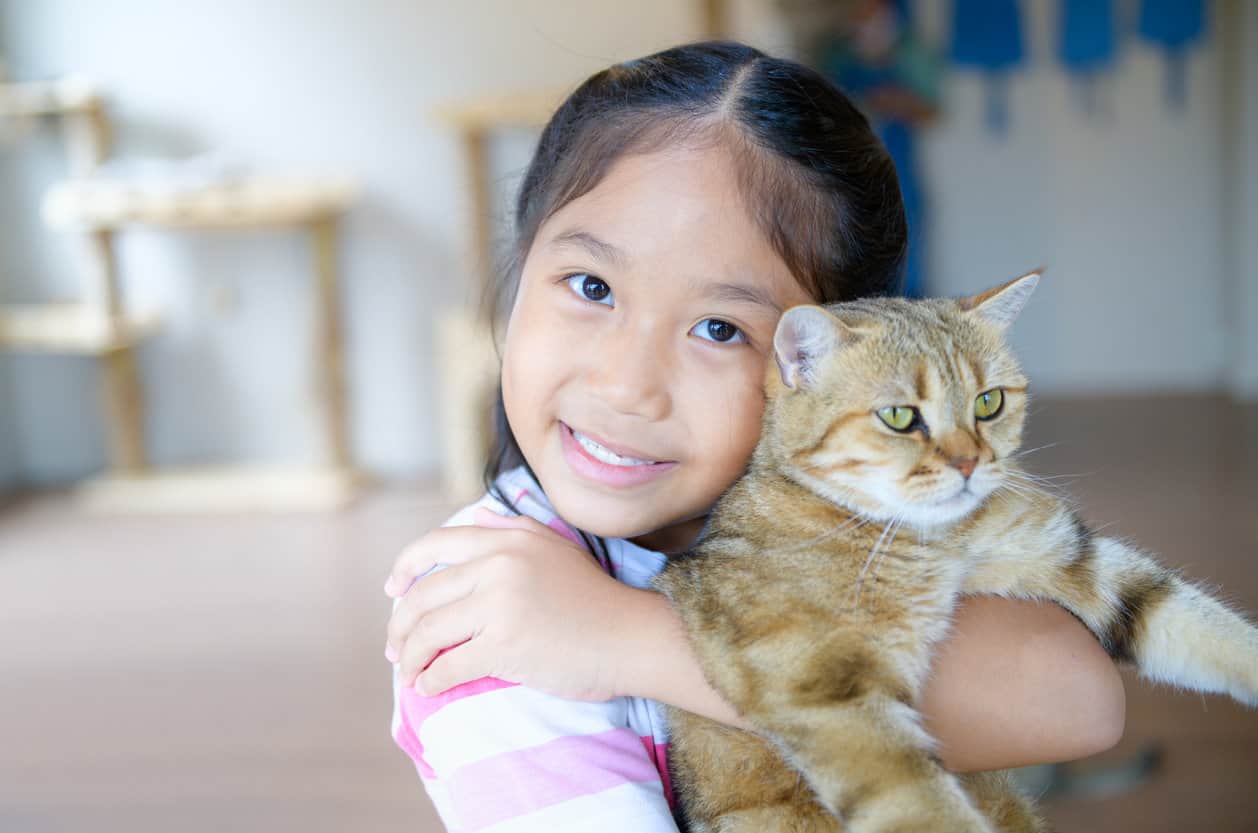
10 Ways to Make Your Cat Live Longer
The oldest cat to ever live passed away at the old age of 38. On average, household cats live between […]
-
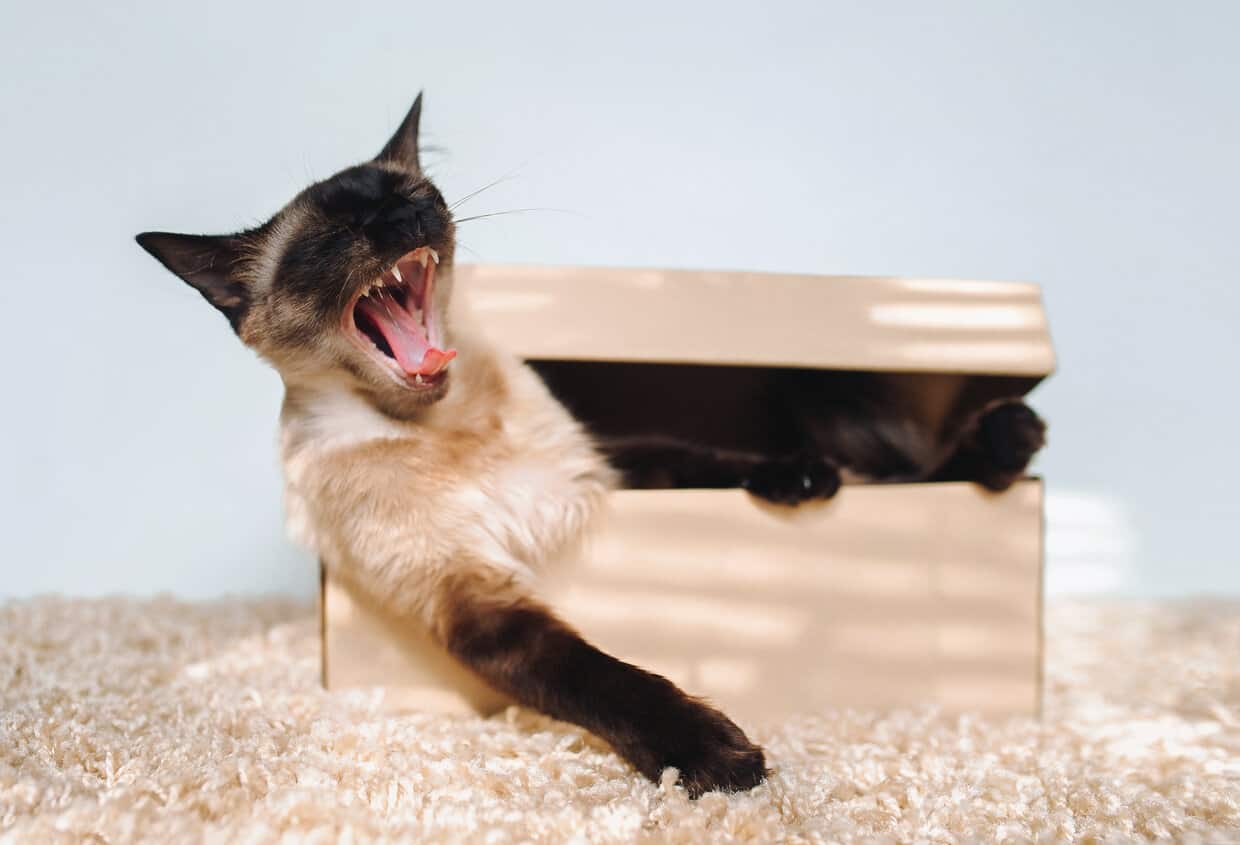
12 Reasons Why Siamese Cats Cry at Night
Siamese cats are a popular breed of cats that many people choose to have as pets. Perhaps you have heard […]
-
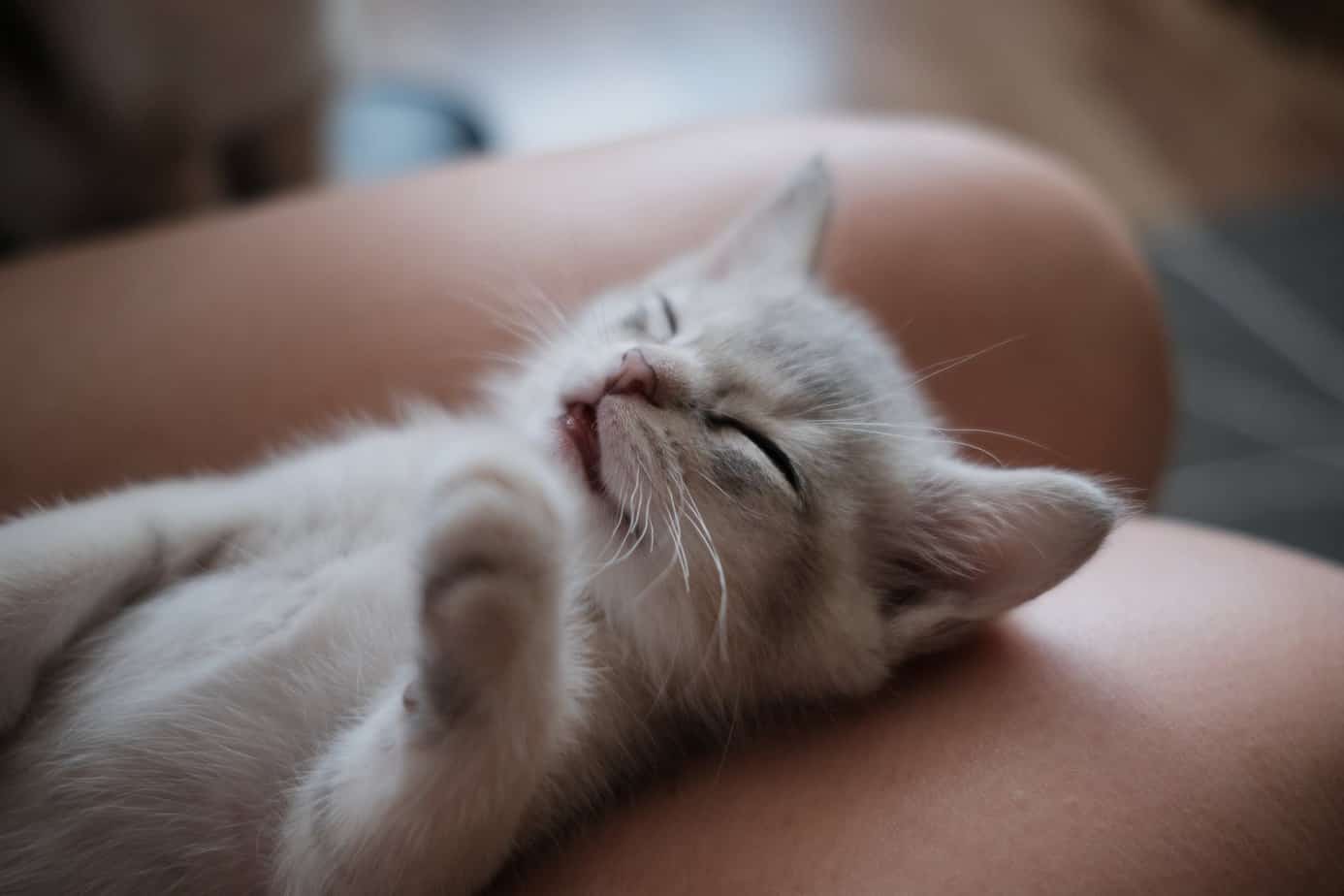
15 Incredible Ways That Cats Show Affection For Humans
Wondering how cats show their affection for humans? We have listed several incredible ways that cats are trying to show their love for us.

